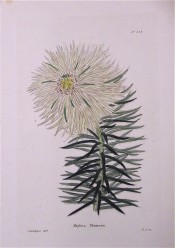Phylica plumosa L.
Frost tender, bushy, downy shrub with wiry stems, lance-shaped leaves, to 3cm long, and plume-like inflorescences of tiny, cup-shaped, dark brown flowers with long whitish hairs in spring. To 2m. [RHSE].
Horticultural & Botanical History
Introduced to Britain in 1759. [JD]. ‘This is a native of the Cape of Good Hope: it has been cultivated in England since 1759, but has never been plentiful. It flowers in the spring, and its rich feathery branches are very beautiful: it may be increased either by seeds, (which may be obtained from its native country, as it produces none here,) or by layers, which require two years in general to make sufficient roots. They should have rather small pots and sandy peat earth, keeping them in a greenhouse in the winter, with abundance of air and not too much water.’ [LBC no.253/1818].
History at Camden Park
Probably short-lived in the gardens as it is only listed in the 1850 catalogue.
Notes
Phylica plumosa E.Mey. ex Sond. (1860) = Phylica ambigua Sond.
Published Feb 28, 2010 - 12:50 PM | Last updated Feb 28, 2010 - 12:59 PM
| Family | Rhamnaceae |
|---|---|
| Category | |
| Region of origin | South Africa |
| Synonyms |
|
| Common Name | Cape myrtle |
| Name in the Camden Park Record |
Phylica plumosa |
| Confidence level | high |
